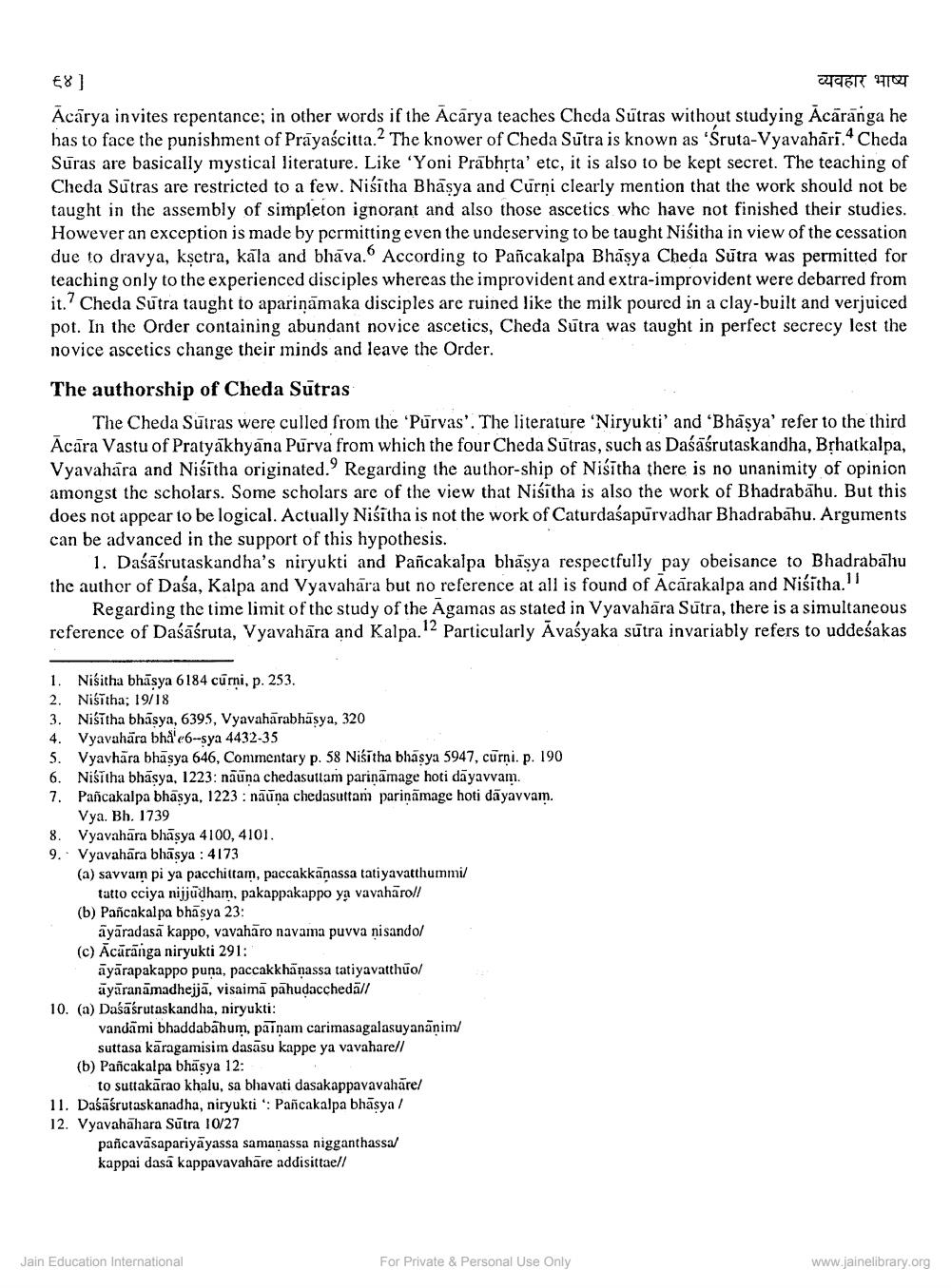________________
€8]
व्यवहार भाष्य Acārya invites repentance; in other words if the Acārya teaches Cheda Sutras without studying Acaranga he has to face the punishment of Prayascitta.The knower of Cheda Sūtra is known as 'Sruta-Vyavahārī.4 Cheda Sūras are basically mystical literature. Like 'Yoni Prabhsta' etc, it is also to be kept secret. The teaching of Cheda Sutras are restricted to a few. Niśītha Bhasya and Curni clearly mention that the work should not be taught in the assembly of simpleton ignorant and also those ascetics whc have not finished their studies. However an exception is made by permitting even the undeserving to be taught Niśitha in view of the cessation due to dravya, kşetra, kāla and bhāva. According to Pancakalpa Bhāsya Cheda Sutra was permitted for teaching only to the experienced disciples whereas the improvident and extra-improvident were debarred from it.? Cheda Sutra taught to apariņāmaka disciples are ruined like the milk poured in a clay-built and verjuiced pot. In the Order containing abundant novice ascetics, Cheda Sūtra was taught in perfect secrecy lest the novice ascetics change their minds and leave the Order. The authorship of Cheda Sutras
The Cheda Sutras were culled from the 'Purvas'. The literature 'Niryukti' and 'Bhāsya' refer to the third Ācāra Vastu of Pratyakhyāna Purva from which the four Cheda Sutras, such as Daśāśrutaskandha, Brhatkalpa, Vyavahara and Niśitha originated. Regarding the author-ship of Niśitha there is no unanimity of opinion amongst the scholars. Some scholars are of the view that Niśitha is also the work of Bhadrabahu. But this does not appear to be logical. Actually Niśitha is not the work of Caturdaśapūrvadhar Bhadrabahu. Arguments can be advanced in the support of this hypothesis.
1. Daśāśrutaskandha's niryukti and Pancakalpa bhasya respectfully pay obeisance to Bhadrabahu the author of Dasa, Kalpa and Vyavahara but no reference at all is found of Acārakalpa and Niśitha.
Regarding the time limit of the study of the Agamas as stated in Vyavahāra Sūtra, there is a simultaneous reference of Daśāśruta, Vyavahāra and Kalpa. 12 Particularly Āvaśyaka sūtra invariably refers to uddeśakas
1. Niśitha bhāsya 6184 cūrni, p. 253. 2. Niśitha; 19/18 3. Nisitha bhāsya, 6395, Vyavahārabhāsya, 320 4. Vyavahāra bhå' c6-sya 4432-35 5. Vyavhara bhasya 646, Commentary p. 58 Niśitha bhasya 5947, curni. p. 190 6. Niśitha bhäsya, 1223: nauna chedasuttam parinämage hoti dāyavvam. 7. Pancakalpa bhāsya, 1223 : näuna chedasuttam pariņāmage hoti dāyavvam.
Vya. Bh. 1739 8. Vyavahāra bhasya 4100, 4101. 9. Vyavahāra bhāsya : 4173 (a) savvam pi ya pacchittam, paccakkānassa tatiyavatthummi/
tatto cciya nijjudham, pakappakappo ya vavaharoll (b) Pancakal pa bhāsya 23:
ayāradasa kappo, vavahāro navama puvva nisando/ (c) Ācāranga niryukti 291:
āyārapakappo puna, paccakkhänassa tatiyavatthüo/
ayaranāmadhejjā, visaima pahudacchedā/l 10. (a) Daśāśrutaskandha, niryukti:
vandāmi bhaddabāhum, painam carimasagalasuyanānim/
suttasa karagamisim dasāsu kappe ya vavahare// (b) Pancakalpa bhāsya 12:
to suttakārao khalu, sa bhavati dasakappavavahare/ 11. Daśāśrutaskanadha, niryukti : Pancakalpa bhāsya / 12. Vyavahahara Sūtra 10/27
pancavāsapariyāyassa samanassa nigganthassa/ kappai dasa kappavavahäre addisittae//
Jain Education International
For Private & Personal Use Only
www.jainelibrary.org




